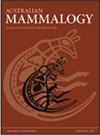在新南威尔士州北部通过相机诱捕揭示长鼻袋鼬的繁殖模式
IF 0.9
4区 生物学
Q3 ZOOLOGY
引用次数: 0
摘要
长鼻杓鹬(Potorous tridactylus)在其分布区北部的繁殖模式尚未被描述过。我们在新南威尔士北部新英格兰台地的八个摄像点对长鼻袋鼬进行了为期 17 个月的连续监测。繁殖的证据依赖于检测到雌性长鼻壶鸟的袋隆起和幼鸟。繁殖活动全年都在进行,但与其他月份相比,5 月和 10 月更常见到鼓包。雌鸟在每个地点产下 2 到 4 只幼鸟,相当于每年 2.1 只。这项研究表明,利用相机诱捕来描述隐蔽有袋类动物的繁殖模式具有巨大的潜力。本文章由计算机程序翻译,如有差异,请以英文原文为准。
Patterns of breeding in the long-nosed potoroo revealed by camera trapping in northern New South Wales
The breeding pattern of the long-nosed potoroo (Potorous tridactylus) has not been described in the north of its geographic range. Long-nosed potoroos were continuously monitored at eight camera sites on the New England Tableland in northern New South Wales over a 17-month period. Evidence of breeding relied on detecting females with pouch bulges and young-at-foot. Breeding occurred throughout the year but pouch bulges were more commonly seen in May and October than in other months. Females produced two to four young per site, equating to 2.1 per year. This study has demonstrated the great potential of using camera trapping to describe aspects of the breeding pattern in a cryptic marsupial.
求助全文
通过发布文献求助,成功后即可免费获取论文全文。
去求助
来源期刊

Australian Mammalogy
ZOOLOGY-
CiteScore
2.50
自引率
8.30%
发文量
26
期刊介绍:
Australian Mammalogy is a major journal for the publication of research in all branches of mammalogy. The journal’s emphasis is on studies relating to Australasian mammals, both native and introduced, and includes marine mammals in the Antarctic region. Subject areas include, but are not limited to: anatomy, behaviour, developmental biology, ecology, evolution, genetics, molecular biology, parasites and diseases of mammals, physiology, reproductive biology, systematics and taxonomy.
Australian Mammalogy is for professional mammalogists, research scientists, resource managers, consulting ecologists, students and amateurs interested in any aspects of the biology and management of mammals.
Australian Mammalogy began publication in 1972 and is published on behalf of the Australian Mammal Society.
 求助内容:
求助内容: 应助结果提醒方式:
应助结果提醒方式:


